
13 minute read
The Fairfield Trust Collection
from Important Paintings & Contemporary Art: including the Fairfield Trust Collection, Wellington
by ART+OBJECT
Since founding Art+Object in early 2007, we have been privileged with numerous private collections. Provenanced private collections such as that of Les and Milly Paris, Michael Seresin, David and Angela Wright, Ron Sang, Dame Judith Binney and Sebastian Black, Michael Dunn, Tim and Sherrah Francis, Anne Coney, Glenn Schaeffer, Marti Friedlander, Frank and Lyn Corner, and Adrian Burr and Peter Tatham, have served to tell us a great deal about both the nature of the personalities of these collectors and about contemporary and modern New Zealand and international art. Many of these collections originated in Wellington, the cultural capital of art collecting in this country.
This collection, despite also hailing from the capital, presents us with something altogether different. It is a collection without an identity, an anonymous portrait of the collector without a face.
At its most basic, a collection is merely an accumulation of things taken to the point, at least when successful, whereby the whole becomes greater than the sum of its parts. Here we are left with a collection altogether dissimilar to the abovementioned private collections made public, yet nonetheless something as equally fascinating. A portrait of a collector comprised solely by the art they have chosen to surround themselves with.
Of course, there are some clues, and the collection cannot help but reveal something of the nature of the collector. These can come in the form of provenance. A number of the works in the collection have appeared in monographs, been requested for significant public exhibitions and been on longterm loan at public galleries: a sure-fire sign of the acuity of the collector’s eye. Like many of the Wellington collections which have preceded this one, it is immediately discernible that it has been put together by someone with a vision in mind. There are unifying threads. The multiple examples of works by Bill Hammond and Ralph Hotere. An emphasis on the graphic and literary over the expressive and/or abstract. Buying work either through the primary or secondary market suggests a firm vision and desire to hunt out the right work, of filling a gap, when the opportunity presents itself.
The prescience of the purchase of Song Book at auction in 1995, clearly one of Hammond’s great works of the 1980s, is one such example. Another particularly meaningful acquisition in the same year is the Toss Woollaston portrait of his wife Edith, straight from the collection of Ron O’Reilly, the Christchurch City Librarian who Colin McCahon referred to as “my oldest supporter”. Seldom does a work appear with more esteemed provenance in this country.
Further works point towards a knowledgeable and welltravelled collector, interested in and aware of connections and precursors to our own history. Prints by Antoni Tāpies and Joan Miró provide a strong lineage to the work of Ralph Hotere and Michael Illingworth respectively. Furthermore, a ceramic piece by Tony Fomison, a slate work by Denis O’Connor and Ralph Hotere’s three-dimensional screen Aramoana, Koputai, all allude to a collector with a strong desire to collect art which challenges and provokes.
Ben Plumbly
iron-glazed earthenware signed and dated Whangarei about 1981 verso
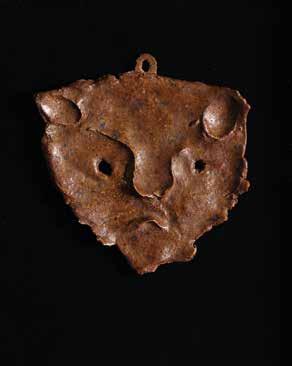
115 x 123 x 10mm
$1500 – $2500
The Thimble mixed media and slate title inscribed, signed and dated May 1996 and inscribed from a Seamus Heaney poem (after hearing him read in London) verso
555 x 277 x 40mm
$4500 – $6500
3
Patricia France
The Red Jacket oil on board signed indistinctly (lower left); title inscribed and dated 1986 on catalogue label affixed verso

465 x 530mm
$7000 – $10 000
Provenance
Collection of Marti Friedlander, 1997. Acquired from FHE Galleries, Auckland.
4
Patricia France
Mirror of Experience oil on board title inscribed and dated 1986 on artist’s paper label affixed verso 480 x 395mm

$6500 – $10 000
Provenance
Purchased from FHE Galleries, Auckland, July 1988.
Patrick Hayman
(United Kingdom, 1915–1988)
The Ship of Fools oil and light impasto on board signed; title inscribed, signed and dated 1987 verso; original Hayward Gallery, London label affixed verso

200 x 603mm
$3500 – $5500
Provenance
Collection of Barbara Hayman.
Purchased from FHE Galleries, Auckland.
6
Patrick Hayman
(United Kingdom, 1915–1988)
The dragon, the white hunter and the ghost lady gouache, coloured pencil and pastel on paper title inscribed, signed and dated ’87
300 x 430mm
$2000 – $3500
Provenance
Collection of Barbara Hayman. Purchased FHE Galleries, Auckland.
Antoni Tàpies (Spain, 1923–2012)
Garfismes Vermeil’s (Red Graphics) etching and aquatint, 14/50 (1998) signed 410 x 320mm
$1500 – $2500
8
Antoni Tàpies (Spain, 1923–2012)


Initiales (Initial) etching and aquatint, 5/50 (1999) signed 360 x 310mm
$1500 – $2500
9
Joan Miró (Spain, 1893–1983)

From Saccades III etching with aquatint on paper, published in Paris in 1962 from Miro’s triple illustrated book: Three Poetic Collections, edition of 125 167 x 202mm: sheet
$800 – $1400
Provenance
Purchased in San Francisco, May 1995.
Bill Hammond Song Book
acrylic and metallic pigment on ten particle boards, diptych title inscribed, signed and dated 1986; original Dunedin Public Art Gallery loan label affixed verso 1520 x 1205mm
$130 000 – $180 000
Exhibited
‘Bill Hammond: 23 Big Pictures’, Dunedin Public Art Gallery, September 11–14 October 1999 (touring).
Illustrated
Justin Paton, Bill Hammond: 23 Big Pictures (Dunedin Public Art Gallery, 1999), p. 31.
Provenance
Purchased Webb’s, Auckland, 22 November 1995, Lot No. 50.
Bill Hammond’s Song Book is likely to be simply heard before its visuals can be noted. Its feedback loop has drumbeats hammering, vocals shattering and amps vibrating set after set. For the pub-rock drummer or percussionist in a folk band, playing skiffle, making sound, is a way of being seen and noticed . And only then, as the viewer steadies themselves against the sonic instability, they will finally experience
Bill Hammond’s Song Book 1986 as a painted surface of introspective rooms, cut off from the world, abutting rather than connected, time-shifted like a storyboard for a flickering movie with a soundtrack on the howl.
Hammond the disrupter puts these things before us to upset the traditional tableaux of New Zealand landscape art. The traditional charm of Peter McIntyre’s ‘New Zealand’ painting is espaliered against the studio wall as Hammond lurches inward rather than outward. The result is a painting of the 1980s age; a painting of competing risks, of self-help gurus and pyramid scheme dossiers, of left versus right Rogernomic infighting—a painting that looks in on itself well before any flicker of the digital was ever conceived. Importantly, Song Book acquires its legendary status by being one of the paintings in the landmark 1999 exhibition Bill Hammond: 23 Big Pictures that travelled to all corners of the country: from the Dunedin Public Art Gallery to The Auckland City Art Gallery/ Toi o Tāmaki, then to the Te Manawa Art Gallery Palmerston North and City Gallery Wellington/Te Whare Toi. This is quite a fanfare for a midcareer painter. In an interview with Hammond at the time, curator Gwynneth Porter records Hammond’s words in the catalogue … ‘ It’s not autobiography, it’s something else.’1
To get near the ‘something else’ requires looking under Song Book’s covers at the ten collective tableaux ranged around. Hammond inflects these room-like visual images like a cultural engineer taking sides, with labels Song Book I and Song Book II in brushpoint running along the uppermost boundary. The tension in these adjacent rectangles is palpable, their collective power more volcanic than the meandering time sequence of adjacent images in Colin McCahon’s masterwork Six Days in Nelson and Canterbury painted decades before in 1950. Hammond’s writhing landscape motifs of humanoids, trees and mountains are not en plein air; they are ferociously housed together under the one roof. The wall paintings double as windows of artificial light. The trestle tables support ranges of fake mountains in a panoply of window dressing (perhaps for the art dealers of the time), but they also have the measure of inverted egg cartons lining the walls of a makeshift recording studio.
One reading has the left-side panels promoting the inner experience of the audience/listener with deeply-etched reclining figures and the right-side panels offering the adrenalin rush of on-stage/studio performance. There the vocalists stiffen, muscular and stricken, like the sinewy Joe Cocker convulsing in mid-song. The text at central left cites Varetta Dillard’s 1953 rhythm and blues hit Mercy Mr Percy and nearby, a bloodline rope encircles a mountain stack with a noose ready to drag it away. Have mercy. We are pulled across arteries of blood into a nightmare dream sequence loaded with a sense of interiority and claustrophobia. But as writer/curator Justin Paton points out: ‘…secreted in that nightmare, is a dream of protection and retreat: the interior as a refuge for the assailed self.’ 2
Hammond did have haunts of studio refuge in Lyttelton’s former Kilwinning Masonic Lodge in Canterbury Street. In the mid-1980s he brought the Volcano Café and Lava Bar to life, not only with his trademark mountain insignia on the parapet above the brightly-painted door, but until the 2011 earthquake, his painting Volcano Flag was a living bar tab hanging on the wall. There, on Friday nights, for those in the know, he would play drums in The Old Man’s Club band, reputedly placing a piece of paper over the reverberating surface to make it sound like a snare drum. We are reminded of the rolling drumbeat and the restless floating guitar of Fleetwood Mac’s 1968 recording Albatross, because like some ancient mariner, Hammond completes Song Book with fleeting glimpses of this lofty bird.
1 Gwynneth Porter, ‘We have everything and nothing’, Bill Hammond: 23 Big Paintings, 1999, Dunedin Public Art Gallery publication, Dunedin, p18.
2 Juston Paton, ‘Bill Hammond’s Apocalyptic Wallpaper’, ibid. p 8.
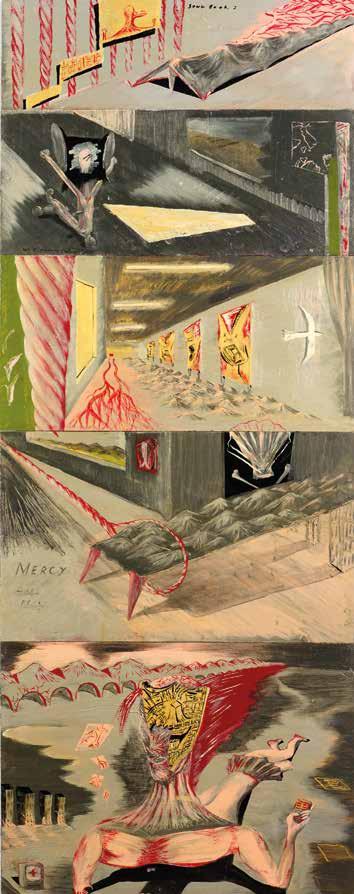

Bill Hammond
Lake Kidney acrylic and metallic pigment on wood title inscribed, signed and dated ’96; original Brooke Gifford Gallery label affixed verso; original Dunedin Public Art Gallery label affixed verso

558 x 1065mm
$75 000 – $100 000
Provenance
Purchased from Brooke Gifford Gallery, Christchurch, 1996.

Carpet Designs ink and graphite on paper, three panels title inscribed, signed and dated 1997 on each

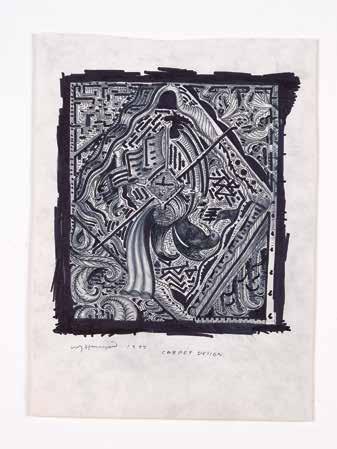

330 x 240mm: each
330 x 720mm: overall
$10 000 – $15 000
Bill Hammond
Custard Chorus Line pastel, graphite and ink on paper title inscribed, signed and dated 1991 498 x 646mm
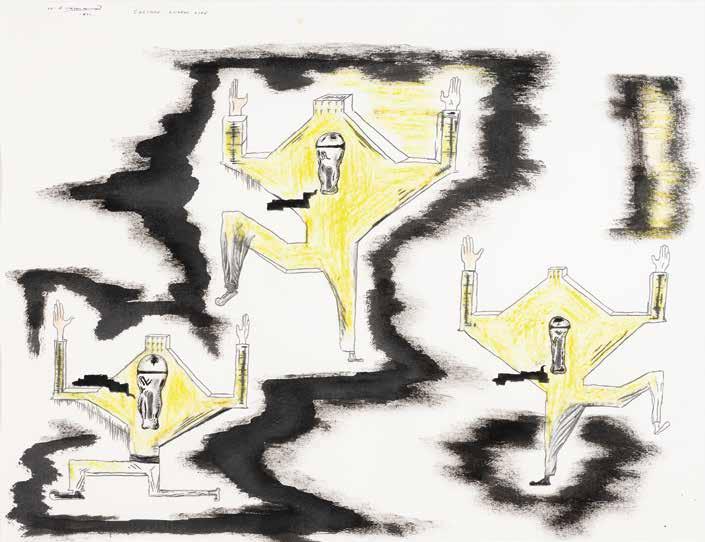
$14 000 – $22 000
Provenance
Purchased from Gregory Flint Gallery, Auckland.
14
Bill Hammond
Drinking, Eating, Smoking lithographs, triptych 23/25; 18/25; 23/24 signed and dated 1992 565 x 430mm: each 565 x 1290mm: overall



$12 000 – $18 000
Provenance
Purchased from Peter McLeavey Gallery, Wellington.
15
Bill Hammond
Girl Singing graphite on paper title inscribed, signed and dated 18/4/81
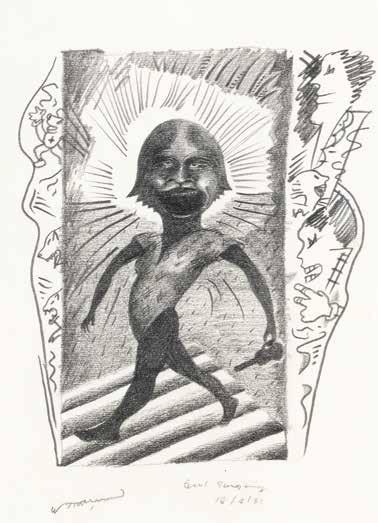
245 x 185mm
$2500 – $4000
Provenance
Private collection Christchurch. Acquired from FHE Galleries, 1998.
Ralph Hotere
Nude (Cilla McQueen) ink on paper inscribed John and Anna in friendship, Ralph Hotere verso

373 x 325mm
$5500 – $7500
Provenance
Collection of John and Anna Caselberg, Dunedin. Purchased FHE Galleries, Auckland, 1997.

17
Ralph Hotere
In A Dream of Snow Falling lithograph, 10/24 title inscribed, signed and dated ’96
757 x 575mm
$6000 – $9000
Provenance
Purchased from Janne Land Gallery, Wellington.
Ralph Hotere 4 + 4 metallic oxides on glass, gold leaf and gold dust in original Colonial villa window frame title inscribed, signed and dated ’96 995 x 900 x 40mm
$200 000 – $300 000
Exhibited
‘Ralph Hotere: Black Light’, Dunedin Public Art Gallery, March – May 2000 (touring nationally).
Illustrated
Ian Wedde et al. (eds), Ralph Hotere: Black Light (Te Papa Press, 2000), p. 99.
Provenance
Private collection, Dunedin. Purchased from FHE Galleries, Auckland, 1998.
Ralph Hotere produced a number of works entitled Lo Negro Sobre Lo Oro, initiated in 1991, which were predominantly black lacquered works on glass, with gold leaf, and gold dust, set within recycled colonial window frames. 4+4 (1996) is one of the finest of these works. Others include Lo negro sobre lo oro (1992) (Te Papa) and Night window Carey’s Bay (1995). In most cases gold leaf was applied to the underside of the glass then painted over with black lacquer — hence the title of the series which translates as ‘the black over the gold’. The work is then viewed through the glass from the opposite side to the applied paint and the gold leaf appears as encased within the black. In many of these works, four square swatches of gold leaf are set within the four corners of the frame. Sometimes the gold is arranged in the form of a cross, and other times the application is of a fluid nature, resembling flame or liquid. In one work, the gold is rendered in an expressionistic splattering wherein parts the gold forms a layer from which clouds of dust emanate. The predominant quality of the surfaces of the Lo Negro Sobre Lo Oro works is characteristically reflective, creating an effect that intentionally places the viewer mirrored within the image. The gloss finish literally reflects the presence of the viewer, so in a sense the viewer becomes part of the interpretation of the work. The title and the juxtaposition of black and gold are full of resonances both spiritual and quotidian. The smears of gold leaf are redolent of the candle light of a Catholic mass, or the gilded surfaces of much Catholic architecture. Gold recalls the iconography of the gold haloes of saints of medieval painting, or its use to represent heaven in the background planes of religious icons. For American art historian, Thomas McEvilley, gold is “an expression of a religiosity that exalts death as well as life, or conflates them into a Liebstod or love-death unity.” The title also betrays the connection of these works with Hotere’s experience in Spain (his first visit to Spain was in the 1960s and there were subsequent return visits). One version has ‘Window in Spain’ inscribed on its surface, and surely he would have known the following lines of Federico García Lorca’s poem Noche/Night, almost an ekphrasis of his own painting 4+4:
Ventanitas de oro Little windows of gold tiemblan, trembling, y en la aurora se mecen and cross upon cross cruces superpuestas. rocking in the dawn.
The gold leaf of 4+4 is a liquid evanescent presence, four squares of gold leaf are placed in formal alignment with the window frame, the gold bleeds into the black, the square edges smudge and fall apart into dust in a controlled demolition. The jostle of mismatched marks and textures enable an exhilarating sense of participation, as if we are viewing a calculated process of disintegration. Hotere’s textures stumble over one another in bouquets of slithery spirals dense with detail. Four tiny crosses chase each other down the centre line into oblivion refusing to be decoded. Gregory O’Brien has convincingly shown that the ‘tenebrae’, the darknesses of Hotere’s art and their perpetual swallowing up of meaning, recreate for the viewer the mystical rapture of traditions of Catholicism. The series Lo Negro Sobre Lo Oro is, to paraphrase Ian Wedde, one of the multiple ways Hotere claimed black as his signature and the darkness as illumination. Pacific writer Albert Wendt, in Merata Mita’s documentary on Hotere, insists that he restores ‘to the colour black, or to darkness, the Māori and Polynesian view of darkness as being the very fecund and fertile darkness out of which all life comes, because it is a live creature … the darkness itself is very alive.’ If 4+4 strikes me as a culminating work, it is because it feels rash, rough, magnetic in its doubt as well as its confidence. In a word, alive.
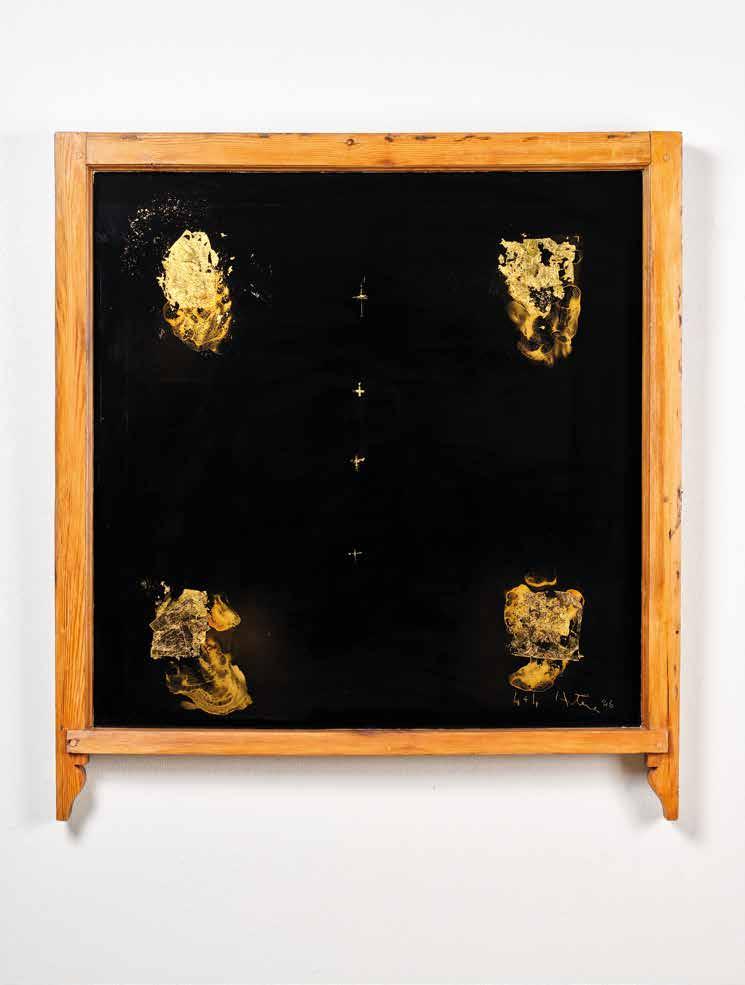
The format of the double-sided, hinged, free-standing, painted wooden screen has appealed to many New Zealand artists, including Colin McCahon, Gordon Walters, Pat Hanly, Ralph Hotere, Bill Hammond and others. Ron Sang’s Hotere (2008), reproduces five screens, including the present work, while a sixth, The Wind I & II is included in Gregory O’Brien’s Hotere: Out the Black Window (1997); there may well be others among Hotere’s enormous output. Of the six known screens, three date from 1976, one from 1979 ( Aramoana, Koputai ), and two from 1987-88).
While the last two works are painted on stainless steel, the other four have a similar construction and format: the front consists of a double image on canvas, while the back consists of six canvas squares (three to each panel) within wide wooden frames. In Aramoana/Koputai the images and writing on the back are confined to the canvas squares, whereas in the three 1976 screens words are stencilled onto the wooden surrounds. Aramoana/ Koputai is thus unique in the way the screen format is utilised.
Aramoana/Koputai was included in the exhibition Hotere: Out the Black Window at City Gallery, Wellington in 1997. In the accompanying book, Gregory O’Brien explains the title: ‘Aramoana’ (meaning ‘pathway to the sea’) is of course the sand-dune spit at the mouth of Otago Harbour, which figures recurrently in Hotere’s work of the 1970s and 80s as the site of a projected aluminium smelter, against the construction of which he and thousands of others successfully protested. The abstract image spreading across the front may be construed as an implicit outcry at such environmental desecration. O’Brien explains the significance of ‘Koputai’ (meaning ‘high tide’) as follows: ‘A traditional Maori tale has it that a group of Maori went to sleep on the beach at Port Chalmers and awoke to find their canoes had drifted away on the tide, at which they exclaimed “Koputai!” ‘ (O’Brien, p. 83).
The double title replicating the format of the hinged and doublesided screen, evokes the whole cherished environment of Otago harbour from Port Chalmers (where Hotere lived and had his studio) to the open ocean at Aramoana, and this emphasis on place and name is repeated on the back as four of the six panels include Maori place names (written in varying scripts and colours) for the hills, islands and other locations on and around the harbour: Mihiwaka, Mopanui, Rangiriri, Kamamautarua, Nga Tamariki O Parewa, Te Ara O Te Makau and Tereweka. It is a roll-call, a litany of names, to evoke personal and tribal attachment to the region as threatened by industrial capitalism.
The single back-panel in English quotes from Ezekiel 36: 28 in the Old Testament: ‘And ye shall dwell in the land I gave to your fathers and ye shall be my people and I will be your God’. As O’Brien remarks such biblical prophecies ‘carry strong associations with Maori millenarian movements – they are important statements of the relationship between the land and its inhabitants’ (p. 45)
This majestic work, so rich and varied in its imagery and connotations, comes from the living core of Hotere’s artistic being and heritage.
Peter Simpson
19
Ralph Hotere
Aramoana, Koputai acrylic on canvas panels mounted on wooden frames set inside two panel folding screen. signed and dated ’79 and variously inscribed 1545 x 607mm
1545 x 900 x 550mm: installation size variable
$120 000 – $180 000
Provenance
Purchased from Judith Anderson Gallery, Auckland, 1994.
Exhibited
‘Hotere: Out the black window’, City Gallery, Wellington, June 1997.
Illustrated
Gregory O’Brien, Hotere: Out the Black Window – Ralph Hotere’s work with New Zealand Poets (Godwit, 1997), p. 44.

20
Michael Shepherd
Plans for a Monument: One Land-One People


Onward NZ
Building Bridges
A Great Victory! (Is in sight)
The Communication of Colonialism
Lest We Forget (Language of Colonialism)









